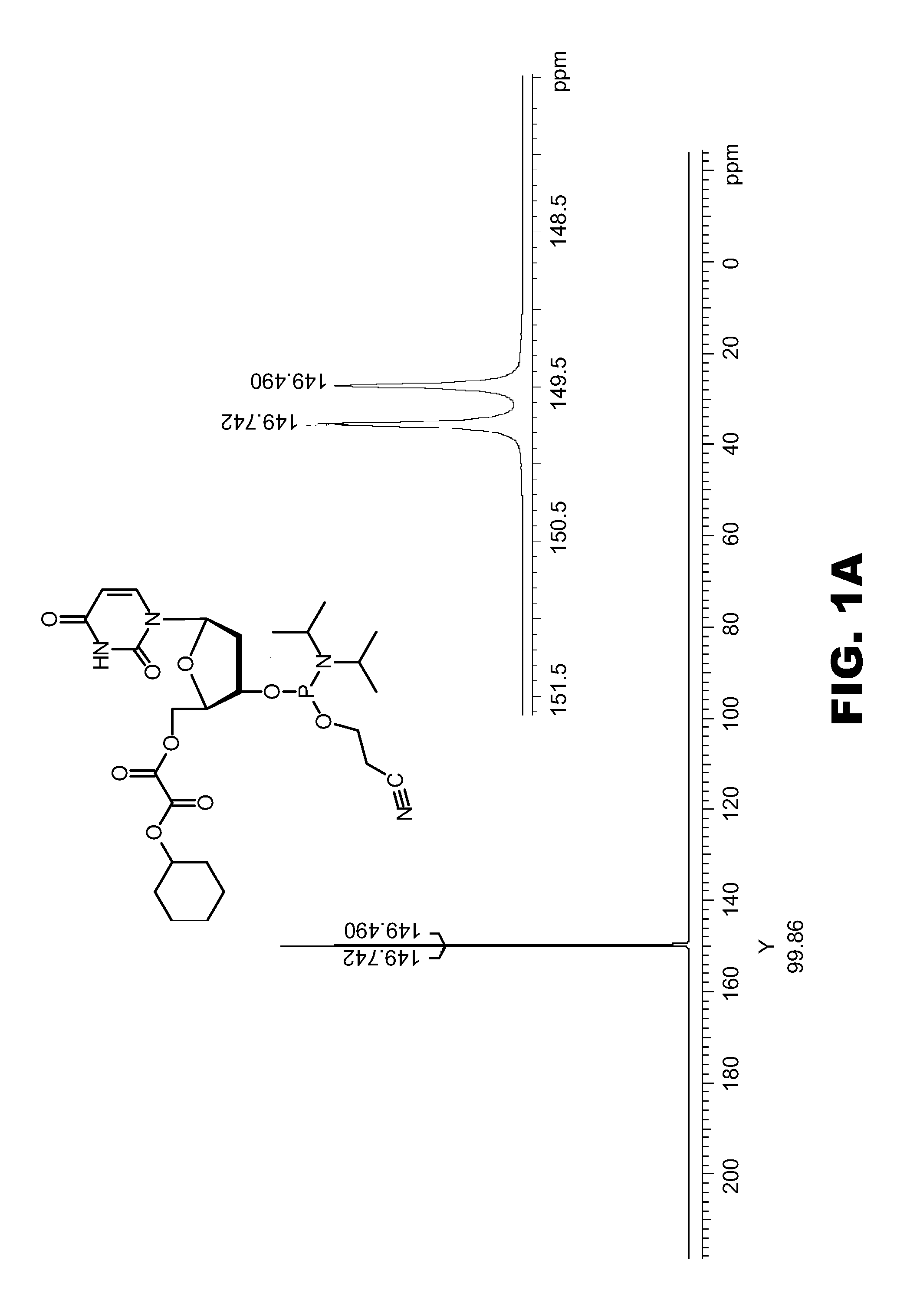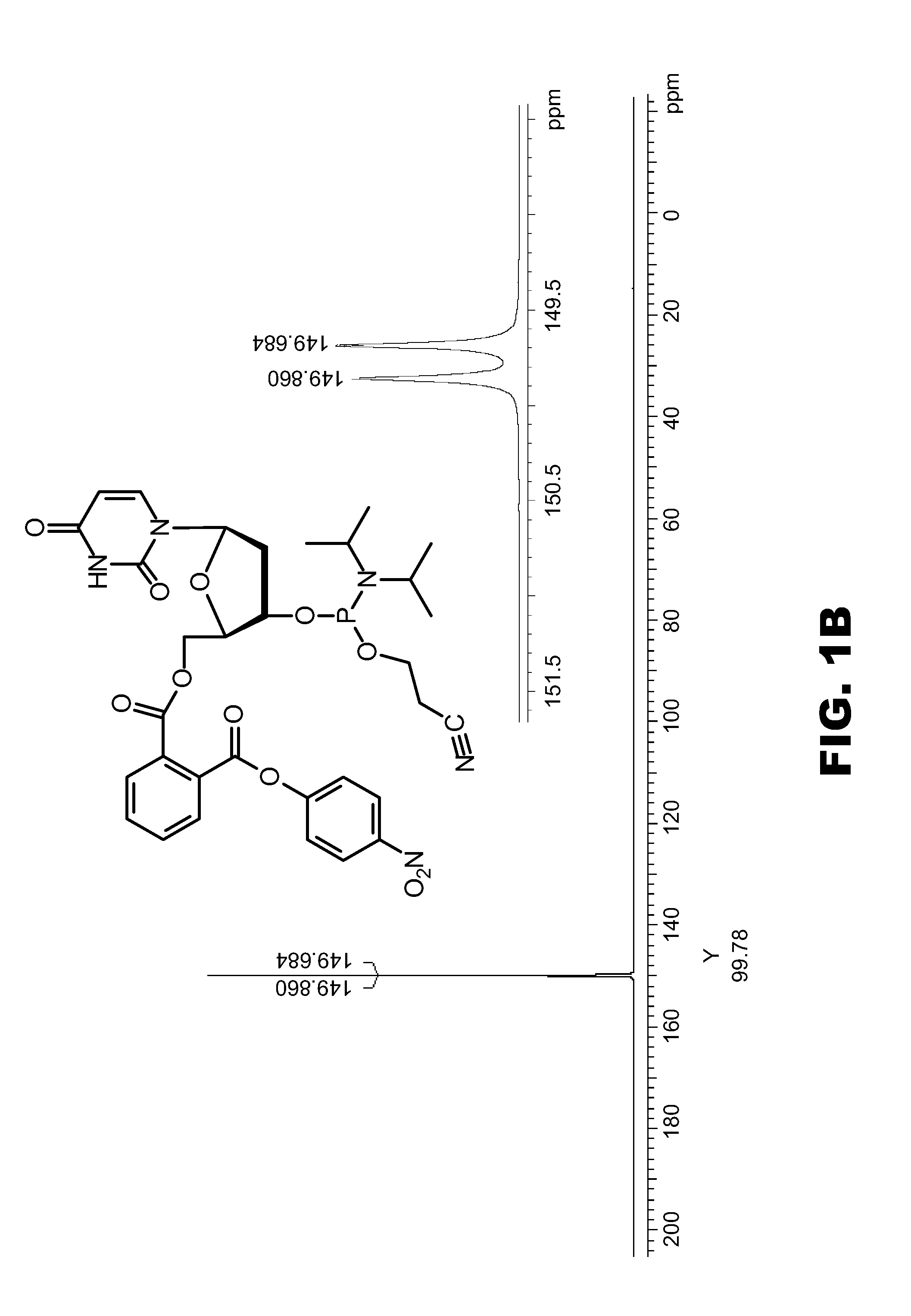Process for the synthesis of oligonucleotides
a technology of oligonucleotide and synthesis process, which is applied in the field of nucleotide chemistry, can solve the problems of inability to remove reagents from products, inconvenient synthesis, and large consumption of aggressive and harmful reagent solutions,
- Summary
- Abstract
- Description
- Claims
- Application Information
AI Technical Summary
Benefits of technology
Problems solved by technology
Method used
Image
Examples
example 1
Synthesis of 5′-acyl-3′-tert.-butyidimethylsilylthymidines (6a-f)
Synthesis of O3′-tert.-butyidimethylsilyl-O5′-trichloroacetylthymidine, TCA-dT-Si (6a)
[0098] O3′-tert.-Butyldimethylsilylthymidine (5) (6 g, 1.0 equiv.) was dissolved in pyridine (50 ml). Trichloroacetyl chloride (1.1 equiv.) was added with cooling (ice bath) and the reaction was continued at ambient temperature for 1 hour. The mixture was concentrated to a syrupy residue by evaporation. The residue was dissolved in dichloromethane (100 ml) and the resulting solution was extracted with water (3 times 100 ml). The organic phase was dried over sodium sulfate and evaporated to a foam. Purification by column chromatography on silica gel gave pure (98.9%) TCA-dT-Si (6a) (5.6 g, 66% yield).
Synthesis of O3′-tert.-butyidimethylsilyl-O5′-ethoxydicarbonylthymidine, EtOX-dT-Si (6b)
[0099] O3′-tert.-Butyldimethylsilylthymidine (5) (20 g, 1.0 equiv.) was dissolved in pyridine (100 ml). Commercially available oxalic acid ethyl es...
example 2
Cleavage of 5′-acyl Groups with Various Aliphatic Amines
[0108] A solution of the respective 5′-acyl thymidine derivative (6a-f) (0.1 mmol, 1 ml) in the given solvent was mixed with a reagent cocktail in the same solvent containing the respective amine or amine mixture with or without additives (1 ml) to result in a deprotection reaction mixture with a concentration of 0.05 M for (6a-g). The concentration of amines and addititives in the reagent cocktail were doubled with respect to the deblocking mixture to be investigated. Samples (100 μl, each) were drawn after the respective time points, diluted with acetonitrile (900 μl) and subjected to analysis by RP-HPLC. For kinetic experiments (time points 0.5-4 min) the samples (100 μl) were quenched by addition to a 12.2% solution of acetic acid in acetonitrile and cooling of the remaining mixture to 0° C. The samples were analyzed after the addition of acetonitrile (700 μl) by RP-HPLC on a Waters Novapak C18 column (4 μm, 3.9×150 mm), e...
example 3
Synthesis of CyOX-dT-β-cyanoethyl-amidite (10)
Synthesis of O5′-cyclohexyloxydicarbonylthymidine, CyOX-dT
[0109] O3′-tert.-butyldimethylsilyl-O5′-cyclohexyloxydicarbonylthymidine, CyOX-dT-Si (6d) (30.4 g, 59.5 mmol) was dissolved in dichloromethane (350 ml). A solution of hydrogen fluoride in pyridine (65% HF, 16.7 ml, 600 mmol) was added and the mixture was stirred at ambient temperature for 5 hours. The reaction was quenched by the addition of solid calcium carbonate (35.3 g) and stirred for 1 hour. After removal of the solid material by filtration the organic phase was extracted with 5% sodium hydrogencarbonate solution (2 times 500 ml) and water (2 times 500 ml). The organic phase was dried over sodium sulfate and concentrated to a foam by evaporation. The foam was dissolved in dichloromethane (150 ml) and added dropwise to a mixture of hexanes and diethylether (8:2, v / v, 1800 ml). The precipitate was collected by filtration, washed with a small volume of hexanes and dried under...
PUM
| Property | Measurement | Unit |
|---|---|---|
| Acidity | aaaaa | aaaaa |
| Acidity | aaaaa | aaaaa |
| Dimensionless property | aaaaa | aaaaa |
Abstract
Description
Claims
Application Information
 Login to View More
Login to View More - R&D
- Intellectual Property
- Life Sciences
- Materials
- Tech Scout
- Unparalleled Data Quality
- Higher Quality Content
- 60% Fewer Hallucinations
Browse by: Latest US Patents, China's latest patents, Technical Efficacy Thesaurus, Application Domain, Technology Topic, Popular Technical Reports.
© 2025 PatSnap. All rights reserved.Legal|Privacy policy|Modern Slavery Act Transparency Statement|Sitemap|About US| Contact US: help@patsnap.com



